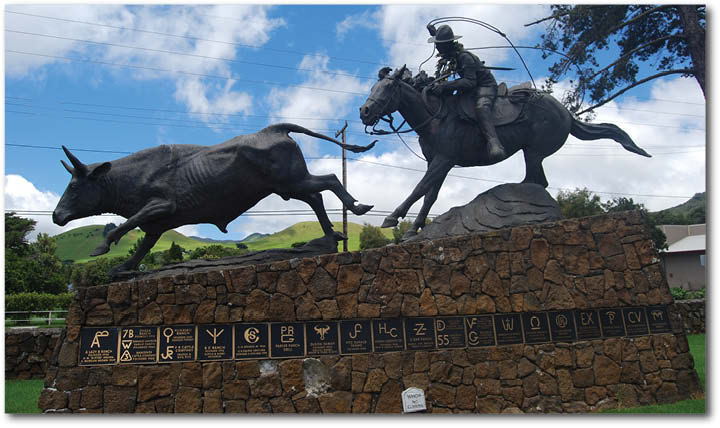
A statue of Ikua Purdy can be found in Waimea, Hawaii. It was created by Arizona artist Fred Fellows.
John Hernandez | Miner
San Manuel Miner
While vacationing in Hawaii recently, I came across a photo/history display of the cattle industry in Hawaii in the lobby area of a hotel in Kona, Hawaii. Hawaiian cowboys or “paniolo” as they are known have an interesting history, one that is even longer than that of American cowboys out west. Yes, there were cowboys in Hawaii before they were in Arizona, Wyoming, Texas or other western states.
The first cattle arrived in Hawaii in 1798. British Captain George Vancouver gave King Kamhehameha I five black longhorn cattle as a gift. King Kamehameha allowed the cattle to range freely and forbid his subjects to harm the cows for 10 years so a herd could be established. Having no natural predators on the Big Island of Hawaii, the cattle soon thrived on the rich grasslands. They multiplied quickly and soon over ran the ranges sometimes getting into the islanders crops and destroying their thatched huts. Within 20 years the wild cattle numbered in the thousands.
In 1809 a 19-year-old sailor from Massachusetts named John Palmer Parker jumped ship on Hawaii. He would find a job tending fish ponds for the King. During the War of 1812 Parker joined the navy. After the war he returned to Hawaii to live and was given exclusive permission to shoot the wild cattle and supply beef, tallow and hides to locals and foreign whalers and sailors. Within a year Parker had a thriving business. The salt beef industry replaced sandalwood as Hawaii’s chief export. Parker soon became a wealthy and respected man. He learned the Hawaiian language and practiced their ways. In 1816 he married King Kamehameha’s granddaughter Kipikane. They would have three children and establish the Parker Ranch in 1847 and a family dynasty that would play an important part in Hawaiian history for the next two centuries.
In 1832 King Kamehameha III sent representatives to California to contract Mexican vaqueros to teach Hawaiians how to ride, rope, and tend cattle. The vaqueros would bring their saddles, boots, spurs, lariats and culture to Hawaii. The skilled horsemen soon taught the Hawaiians how to be cowboys a generation before the American cowboys in the “wild west” became well known. Many of them stayed and married Hawaiian women. The vaqueros also introduced the guitar to Hawaii and taught Hawaiians how to play it. Paniolo is believed to have come from the word Espanol which the Hawaiian cowboys began calling themselves. The paniolo would soon become known world wide.
In 1907 a paniolo Eben “Rawhide Ben” Low helped bring a Wild West show to Honolulu and Hilo, Hawaii. Eben was a well known and popular cowboy in Hawaii. In 1892 he lost a hand in a roping accident while herding wild cattle. He was still a working cowboy and would give exhibitions roping steers with one arm. He had been to the Cheyenne Rodeo in 1907 and believed that some of the paniolo he worked with could rope better than the cowboys he saw in Wyoming.
One of the Wild West show’s performers was the reigning World Champion steer roper Angus McPhee of Wyoming. On the first evening of the show, two Hawaiian cowboys defeated McPhee in a steer roping contest. The newspapers pointed out that McPhee had an excuse for losing. He had been driven in an automobile directly from the harbor upon arrival to the show and had used a borrowed horse of questionable ability. During other shows, paniolo defeated McPhee again although he won some of the contests. McPhee praised the roping skills of the paniolo. The Hawaiian people now knew they could compete against the best.
The Cheyenne Frontier Days Rodeo committee sent an invitation for Hawaii to send four of their top cowboys to the event. They would donate $300 towards travel expenses and provide room and board in Wyoming during their stay. Eben Low paid for the steamship trip to San Francisco and the train ride to Cheyenne to send the paniolo to the rodeo.
Three paniolo made their way to Wyoming in 1908 for the Cheyenne Frontier Days Rodeo. They were Jack Low, Archie Kaaua and Ikua Purdy. The three men who wore floppy hats with a flower lei were laughed at by some of their competitors. The laughing stopped once they saw the Hawaiian cowboys rope. The three paniolo borrowed horses from the local cowboys. Jack Low would finish sixth in steer roping, Archie Kaaua placed third and Ikua Purdy won the steer roping contest. He was now the reigning World Champion. Purdy was the first non-American to win an event at the rodeo where the best cowboys in the world competed. The paniolo were welcomed back to Hawaii as heroes. Ikua Purdy was the great grandson of John Palmer Parker and Kipikane. Purdy never defended his title or left the islands again. He was inducted into the National Cowboy Hall of Fame in 2000. A statue of him stands in the ranching community of Waimea, Hawaii. The artist that created the large statue is Fred Fellows a working cowboy and artist from Sonoita, Arizona who visits Waimea frequently.
The Parker Ranch still exists on the Big Island although it is smaller and has been broken up into other ranches. The Ranch still raises calves that are sent to the mainland, sells natural range fed beef and is open to tourists for horseback riding, hunting and ATV rides. The paniolo cowboys and cowgirls from Hawaii come to the mainland to compete in rodeos as well as compete locally.

